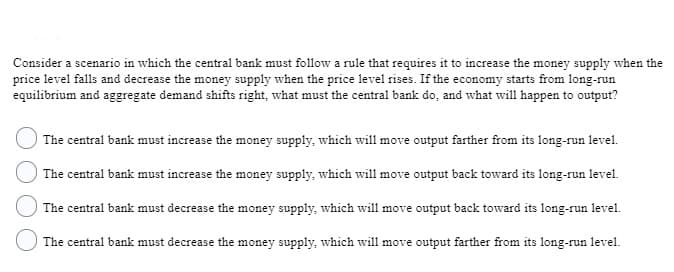Consider a scenario in which the central bank must follow a rule that requires it to increase the money supply when the price level falls and decrease the money supply when the price level rises. If the economy starts from long-run equilibrium and aggregate demand shifts right, what must the central bank do, and what will happen to output? The central bank must increase the money supply, which will move output farther from its long-run level. The central bank must increase the money supply, which will move output back toward its long-run level. The central bank must decrease the money supply, which will move output back toward its long-run level. The central bank must decrease the money supply, which will move output farther from its long-run level.
Consider a scenario in which the central bank must follow a rule that requires it to increase the money supply when the price level falls and decrease the money supply when the price level rises. If the economy starts from long-run equilibrium and aggregate demand shifts right, what must the central bank do, and what will happen to output? The central bank must increase the money supply, which will move output farther from its long-run level. The central bank must increase the money supply, which will move output back toward its long-run level. The central bank must decrease the money supply, which will move output back toward its long-run level. The central bank must decrease the money supply, which will move output farther from its long-run level.
Essentials of Economics (MindTap Course List)
8th Edition
ISBN:9781337091992
Author:N. Gregory Mankiw
Publisher:N. Gregory Mankiw
Chapter22: Money Growth And Inflation
Section: Chapter Questions
Problem 1PA
Related questions
Question
Help thanks

Transcribed Image Text:Consider a scenario in which the central bank must follow a rule that requires it to increase the money supply when the
price level falls and decrease the money supply when the price level rises. If the economy starts from long-run
equilibrium and aggregate demand shifts right, what must the central bank do, and what will happen to output?
|The central bank must increase the money supply, which will move output farther from its long-run level.
|The central bank must increase the money supply, which will move output back toward its long-run level.
The central bank must decrease the money supply, which will move output back toward its long-run level.
The central bank must decrease the money supply, which will move output farther from its long-run level.
Expert Solution
This question has been solved!
Explore an expertly crafted, step-by-step solution for a thorough understanding of key concepts.
Step by step
Solved in 2 steps

Knowledge Booster
Learn more about
Need a deep-dive on the concept behind this application? Look no further. Learn more about this topic, economics and related others by exploring similar questions and additional content below.Recommended textbooks for you

Essentials of Economics (MindTap Course List)
Economics
ISBN:
9781337091992
Author:
N. Gregory Mankiw
Publisher:
Cengage Learning

Brief Principles of Macroeconomics (MindTap Cours…
Economics
ISBN:
9781337091985
Author:
N. Gregory Mankiw
Publisher:
Cengage Learning

Principles of Macroeconomics (MindTap Course List)
Economics
ISBN:
9781285165912
Author:
N. Gregory Mankiw
Publisher:
Cengage Learning

Essentials of Economics (MindTap Course List)
Economics
ISBN:
9781337091992
Author:
N. Gregory Mankiw
Publisher:
Cengage Learning

Brief Principles of Macroeconomics (MindTap Cours…
Economics
ISBN:
9781337091985
Author:
N. Gregory Mankiw
Publisher:
Cengage Learning

Principles of Macroeconomics (MindTap Course List)
Economics
ISBN:
9781285165912
Author:
N. Gregory Mankiw
Publisher:
Cengage Learning

Principles of Economics (MindTap Course List)
Economics
ISBN:
9781305585126
Author:
N. Gregory Mankiw
Publisher:
Cengage Learning

Principles of Economics, 7th Edition (MindTap Cou…
Economics
ISBN:
9781285165875
Author:
N. Gregory Mankiw
Publisher:
Cengage Learning

Principles of Macroeconomics (MindTap Course List)
Economics
ISBN:
9781305971509
Author:
N. Gregory Mankiw
Publisher:
Cengage Learning